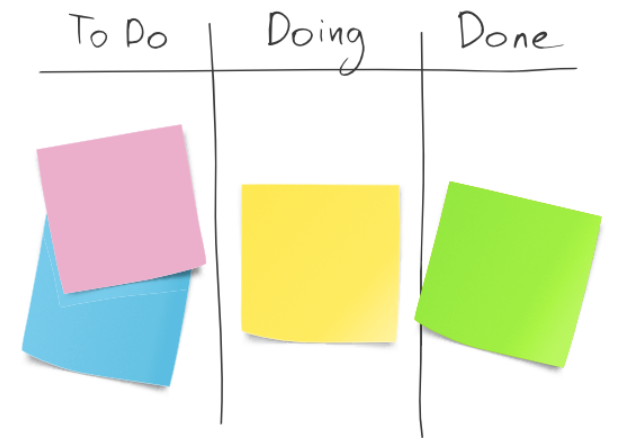
We recently posted about a software development method called ‘Scrum’. It’s a massively agile method, and we’ve outlined the great benefits of this.
There is a second framework that we’d like to introduce to you, which is called ‘Kanban’. It is also majorly agile and has many benefits too, which we will get into below.
Let’s take it back. Welcome to a small History class.
The term Kanban comes from the Japanese and means something like a ‘signal card’. The origin of the framework comes from the famous car manufacturer we know as Toyota. Toyota began to optimize its production process with Kanban in the middle of the 20th century. The framework was of course then further adapted so that it could also be used in IT projects, but there are many ideas at the core that have also helped Toyota to be successful.
Kanban has one main focus – to bring clear structure. Through Kanban and its methods, you will better understand the structure of projects as they are visually represented. This allows for increased overview of processes and clarity for everyone involved in the project. With this method, bottlenecks and the potential for improvements will also be discovered.
Kanban Rules
Like with most things that bring about structure, they also tend to come with a set of rules. It is no different with the Kanban Framework. Here you will find clearly determined rules that ensure structure and thus contribute to the achievement of goals.
Rule 1: Visualize
To get an overview, the first step is to visualize the project. The most important tool in the Kanban Framework for this is what is called ‘The Kanban Board’. At its core, this is a table with at least the following three columns:
1) ToDo
2) In Process
3) Done

In the classic version, the Kanban board is actually a wall or board on which the tasks are entered using sticky notes. The sticky notes contain the tasks to be performed in the project, with a detailed description and all other information. The sticky notes then travel from left to right across the Kanban board until they are classified as complete and archived. It’s a very clever system that keeps everything in check.
Since a physical board requires the entire team to be in one place and is a bit harder to manage, digital boards such as the Trello tool, Monday or Asana are also very popular today.
Rule 2: Set Boundaries
In order to avoid chaos, set boundaries. Be sure to distinguish between tasks appropriately. The number of tasks in each column must be clearly defined. It makes little sense to create a wonderfully organized board if you end up simply jam-packing it with too many tasks.
Rule 3: Measure & Control
It is important to measure key figures. There are things such as the queue or the dwell time of tasks in individual columns. This will allow you to avoid bottlenecks or the backlog of tasks. You might even be able to foresee where you have set too many tasks, and so you can immediately decrease or disperse the tasks to make for a more manageable workload.
Rule 4: Clarify
To ensure that there are no misunderstandings or errors, everyone involved must have a uniform understanding of terms and processes. Consistency in understanding within the team is crucial for the success of the Kanban method. For example, before being able to set a task in the ‘completed’ or ‘done’ column, there needs to be a checklist of sorts that each team member can mentally go through to ensure that their task is indeed 100% done.
Rule 5: Improve
We’ve mentioned this a bit above, but we’d like to reiterate the importance of the rules and the tools that are needed to ensure that the Kanban method works at its highest level. Kanban is meant to continuously improve and optimize your business processes and ultimately, its results too.
It is also important that everyone involved, regardless of their rank in the company, can openly address problems and ideas. This automatically leads to flatter hierarchies and more responsibility around employees.
Kanban Modifications
Kanban is a very flexible framework. Due to this flexibility, a Kanban board can also be adapted and tweaked to suit individual needs.
For example, it may make sense to increase the number of columns on the board, depending on your personal business model. This is particularly useful if there are clear approval processes or different processing stages in the project. This will allow for a more accurate visual representation of a project's progress.
Another popular method is the use of differently colored sticky notes. For example, it can be marked which task belongs to which department. The color can also show the level of importance, so whether a task is critical or an optional task.
The Kanban Board as an instrument can also be used very flexibly in other situations in order to get a better overview. In the Scrum Framework, for example, you can use a Kanban board to visualize backlog and sprint content excellently.
Kanban: The Difference to Scrum
The main question you get asked when you bring up the word ‘Kanban’ is ‘’But how is it different from Scrum?’’.
Well, the two frameworks each deal with different aspects of a project. Scrum primarily regulates the cooperation of the project team, Kanban deals with maintaining an overview of a project and uncovering optimization potential.
They are not the same, but they are also not on opposite ends of the spectrum. They’re simply two frameworks that deal with optimization and bring in organization, but in two completely different spheres within the same project. For example, Kanban is a good addition to the Scrum framework. See how we said ‘addition’, not ‘substitute’ – they can work together for ultimate success.
Conclusion
Kanban is a simple but effective framework for visualizing and controlling projects and processes. Due to its flexibility, Kanban can also complement other methods and frameworks such as Scrum and provide clear added value.
If you would like to know more why not pop us an email on hello@especial.digital or contact us here on our website.
Found this helpful? Share this post with your colleagues and friends

Daniel Kolb
Product Development @ EspecialCONTACT
Would you like to know more?
Let us help you!